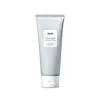What's inside
What's inside
 Key Ingredients
Key Ingredients

 Benefits
Benefits

 Concerns
Concerns

 Ingredients Side-by-side
Ingredients Side-by-side

Opuntia Ficus-Indica Stem Extract
Skin ConditioningWater
Skin ConditioningPEG-8
HumectantMyristic Acid
CleansingStearic Acid
CleansingPotassium Hydroxide
BufferingGlycerin
HumectantLauric Acid
CleansingDipropylene Glycol
HumectantPalmitic Acid
EmollientAlcohol Denat.
AntimicrobialQuillaja Saponaria Bark Extract
CleansingNymphaea Caerulea Flower Extract
Skin ConditioningCitrus Reticulata Peel Extract
Skin ConditioningOpuntia Ficus-Indica Seed Oil
EmollientMoringa Oleifera Seed Oil
EmollientAgave Tequilana Leaf Extract
AstringentGlyceryl Stearate
EmollientPEG-100 Stearate
Bentonite
AbsorbentCoco-Glucoside
Cleansing1,2-Hexanediol
Skin ConditioningPEG-150 Distearate
EmulsifyingPolyquaternium-7
Acrylates/C10-30 Alkyl Acrylate Crosspolymer
Emulsion StabilisingSodium Cocoyl Isethionate
CleansingPEG-14m
Emulsion StabilisingCaprylyl Glycol
EmollientSilica
AbrasiveCitric Acid
BufferingButylene Glycol
HumectantEthylhexylglycerin
Skin ConditioningTocopherol
AntioxidantDisodium EDTA
Sodium Benzoate
MaskingPhenoxyethanol
PreservativeParfum
MaskingBenzyl Salicylate
PerfumingButylphenyl Methylpropional
PerfumingCitronellol
PerfumingEugenol
PerfumingHexyl Cinnamal
PerfumingCI 77007
Cosmetic ColorantOpuntia Ficus-Indica Stem Extract, Water, PEG-8, Myristic Acid, Stearic Acid, Potassium Hydroxide, Glycerin, Lauric Acid, Dipropylene Glycol, Palmitic Acid, Alcohol Denat., Quillaja Saponaria Bark Extract, Nymphaea Caerulea Flower Extract, Citrus Reticulata Peel Extract, Opuntia Ficus-Indica Seed Oil, Moringa Oleifera Seed Oil, Agave Tequilana Leaf Extract, Glyceryl Stearate, PEG-100 Stearate, Bentonite, Coco-Glucoside, 1,2-Hexanediol, PEG-150 Distearate, Polyquaternium-7, Acrylates/C10-30 Alkyl Acrylate Crosspolymer, Sodium Cocoyl Isethionate, PEG-14m, Caprylyl Glycol, Silica, Citric Acid, Butylene Glycol, Ethylhexylglycerin, Tocopherol, Disodium EDTA, Sodium Benzoate, Phenoxyethanol, Parfum, Benzyl Salicylate, Butylphenyl Methylpropional, Citronellol, Eugenol, Hexyl Cinnamal, CI 77007
Water
Skin ConditioningGlycerin
HumectantSodium Cocoyl Isethionate
CleansingSodium Methyl Cocoyl Taurate
CleansingPotassium Cocoyl Glycinate
Coco-Betaine
CleansingPotassium Cocoate
EmulsifyingPolyquaternium-67
Xylitylglucoside
HumectantCitric Acid
BufferingAnhydroxylitol
HumectantSodium Chloride
MaskingBetula Platyphylla Japonica Juice
Skin ConditioningXylitol
Humectant1,2-Hexanediol
Skin ConditioningGlucose
HumectantSodium Acetate
BufferingSodium Hyaluronate
HumectantButylene Glycol
HumectantTrehalose
HumectantAllantoin
Skin ConditioningChamomilla Recutita Flower Extract
MaskingGlycyrrhiza Glabra Root Extract
BleachingCamellia Sinensis Leaf Extract
AntimicrobialPerilla Frutescens Leaf Extract
MaskingOryza Sativa Bran Extract
Skin ConditioningHouttuynia Cordata Extract
Skin ConditioningCentella Asiatica Extract
CleansingCalendula Officinalis Flower Extract
MaskingDisodium EDTA
Potassium Benzoate
PreservativeWater, Glycerin, Sodium Cocoyl Isethionate, Sodium Methyl Cocoyl Taurate, Potassium Cocoyl Glycinate, Coco-Betaine, Potassium Cocoate, Polyquaternium-67, Xylitylglucoside, Citric Acid, Anhydroxylitol, Sodium Chloride, Betula Platyphylla Japonica Juice, Xylitol, 1,2-Hexanediol, Glucose, Sodium Acetate, Sodium Hyaluronate, Butylene Glycol, Trehalose, Allantoin, Chamomilla Recutita Flower Extract, Glycyrrhiza Glabra Root Extract, Camellia Sinensis Leaf Extract, Perilla Frutescens Leaf Extract, Oryza Sativa Bran Extract, Houttuynia Cordata Extract, Centella Asiatica Extract, Calendula Officinalis Flower Extract, Disodium EDTA, Potassium Benzoate
 Reviews
Reviews

Ingredients Explained
These ingredients are found in both products.
Ingredients higher up in an ingredient list are typically present in a larger amount.
1,2-Hexanediol is a synthetic liquid and another multi-functional powerhouse.
It is a:
- Humectant, drawing moisture into the skin
- Emollient, helping to soften skin
- Solvent, dispersing and stabilizing formulas
- Preservative booster, enhancing the antimicrobial activity of other preservatives
Butylene Glycol (or BG) is used within cosmetic products for a few different reasons:
Overall, Butylene Glycol is a safe and well-rounded ingredient that works well with other ingredients.
Though this ingredient works well with most skin types, some people with sensitive skin may experience a reaction such as allergic rashes, closed comedones, or itchiness.
Learn more about Butylene GlycolCitric Acid is an alpha hydroxy acid (AHA) naturally found in citrus fruits like oranges, lemons, and limes.
Like other AHAs, citric acid can exfoliate skin by breaking down the bonds that hold dead skin cells together. This helps reveal smoother and brighter skin underneath.
However, this exfoliating effect only happens at high concentrations (20%) which can be hard to find in cosmetic products.
Due to this, citric acid is usually included in small amounts as a pH adjuster. This helps keep products slightly more acidic and compatible with skin's natural pH.
In skincare formulas, citric acid can:
While it can provide some skin benefits, research shows lactic acid and glycolic acid are generally more effective and less irritating exfoliants.
Most citric acid used in skincare today is made by fermenting sugars (usually from molasses). This synthetic version is identical to the natural citrus form but easier to stabilize and use in formulations.
Read more about some other popular AHA's here:
Learn more about Citric AcidDisodium EDTA plays a role in making products more stable by aiding other preservatives.
It is a chelating agent, meaning it neutralizes metal ions that may be found in a product.
Disodium EDTA is a salt of edetic acid and is found to be safe in cosmetic ingredients.
Learn more about Disodium EDTAGlycerin is already naturally found in your skin. It helps moisturize and protect your skin.
A study from 2016 found glycerin to be more effective as a humectant than AHAs and hyaluronic acid.
As a humectant, it helps the skin stay hydrated by pulling moisture to your skin. The low molecular weight of glycerin allows it to pull moisture into the deeper layers of your skin.
Hydrated skin improves your skin barrier; Your skin barrier helps protect against irritants and bacteria.
Glycerin has also been found to have antimicrobial and antiviral properties. Due to these properties, glycerin is often used in wound and burn treatments.
In cosmetics, glycerin is usually derived from plants such as soybean or palm. However, it can also be sourced from animals, such as tallow or animal fat.
This ingredient is organic, colorless, odorless, and non-toxic.
Glycerin is the name for this ingredient in American English. British English uses Glycerol/Glycerine.
Learn more about GlycerinSodium cocoyl isethionate is a natural ingredient from coconut oil. It is an ultra gentle cleanser that gives a nice foam without drying the skin or impacting the skin barrier.
The amount of foam created depends on the amount of sodium cocoyl isethionate used in the product.
This ingredient also helps improve the spreadability of a product.
Learn more about Sodium Cocoyl IsethionateWater. It's the most common cosmetic ingredient of all. You'll usually see it at the top of ingredient lists, meaning that it makes up the largest part of the product.
So why is it so popular? Water most often acts as a solvent - this means that it helps dissolve other ingredients into the formulation.
You'll also recognize water as that liquid we all need to stay alive. If you see this, drink a glass of water. Stay hydrated!
Learn more about Water